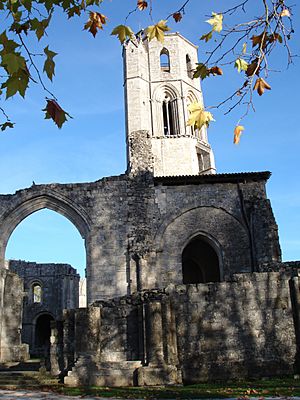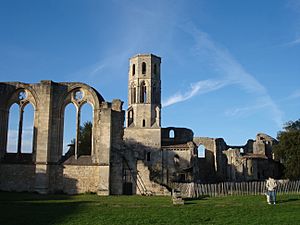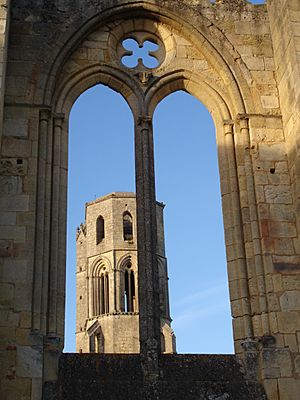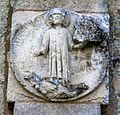Grande-Sauve Abbey facts for kids
Grande-Sauve Abbey, also known as Sauve-Majeure Abbey, was once a large Benedictine monastery. It is located near the village of La Sauve in the Gironde area of France. This region used to be covered by a huge forest.
Even though the abbey is now mostly in ruins, its remaining parts are very important. They show amazing examples of Romanesque architecture, especially the many detailed stone carvings called capitals.
In 1998, the ruins of Grande-Sauve Abbey became part of a UNESCO World Heritage Site. This site includes the famous pilgrimage route that leads to St. James of Compostela in Spain.
Contents
History of Grande-Sauve Abbey
How the Abbey Began
The abbey was founded in 1079 by a man named Gerald of Sauve-Majeure. He chose a spot called Hauteville, which was between two rivers, the Garonne and the Dordogne. Gerald also became the first abbot, or head, of the abbey.
The name "Sauve-Majeure" comes from "Silva Major," which means "great forest." This area was once a huge forest. The land for the abbey was a gift to Gerald from Duke William VIII of Aquitaine.
Growth and Importance
With help from the duke, the Pope, and many generous people, the abbey grew quickly. Even the kings of England and France supported it.
Grande-Sauve Abbey was located on the important route to Santiago de Compostela. It became a starting point for many pilgrims, who were people traveling for religious reasons.
Abbot Gerald passed away in 1095 and was buried at the abbey. In 1197, Pope Celestine III declared him a saint. The main church of the abbey was officially opened in 1231.
Life at the Abbey
The monks at Grande-Sauve Abbey followed the Rule of St. Benedict. This was a set of rules for how monks should live. Their way of life was similar to that of Cluny, another famous monastery, but Grande-Sauve was not part of the Cluniac Order.
During the Middle Ages, the abbey became very rich and powerful. It owned 51 smaller monasteries, called priories, including one in England. Eleanor of Aquitaine, a powerful queen, often stayed there. The abbey's wealth and power were so great that they even rivaled the city of Bordeaux.
However, this wealth also attracted trouble. Bandits from the Basques and the Navarrese often attacked and robbed the abbey. The people living in the nearby town of La Sauve also sometimes rebelled against the rich monks.
Challenges and Decline
The abbey suffered damage during the Hundred Years' War, which lasted from 1337 to 1453, between France and England. Even though it was repaired and made stronger in the 1500s, the abbey's power and money started to decrease. It began a long period of decline.
Later, the community of monks joined a group called the Congrégation des Exempts. In 1667, they became part of the Congregation of St. Maur, another group of Benedictine monasteries.
In 1665, a big storm badly damaged the roofs of the church, the sleeping areas, and the dining hall. The bell tower also collapsed in the late 1600s. In 1759, an earthquake further weakened the church building.
What Happened After the Abbey Closed?
Confiscation and New Uses
During the French Revolution, which began in 1789, the abbey's property was taken away by the government. From 1793, the remaining buildings were used as a prison. The church roof fell in during 1809. For the next 40 years, the abbey's stones were used as a quarry, meaning they were taken to build things in the village of La Sauve.
Later Occupants
In 1837, the local archbishop bought the site. A Jesuit college, which is a type of school, was built there. Later, this college became a training school for teachers. However, in 1910, a fire destroyed the school, and the site was left empty again. Between 1914 and 1918, during World War I, the remaining buildings were used as a small military hospital.
Preservation Today
In 1960, the French government bought the site. They worked to make the ruins stable and safe. Today, Grande-Sauve Abbey is open to the public. It is managed by the Centre des Monuments Historiques, which looks after historical sites in France.
Gallery
See also
 In Spanish: Abadía de la Selva Mayor para niños
In Spanish: Abadía de la Selva Mayor para niños












